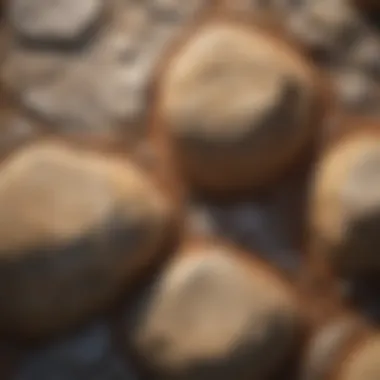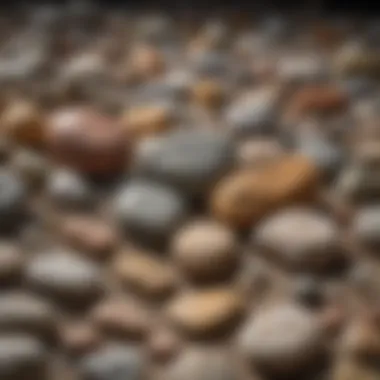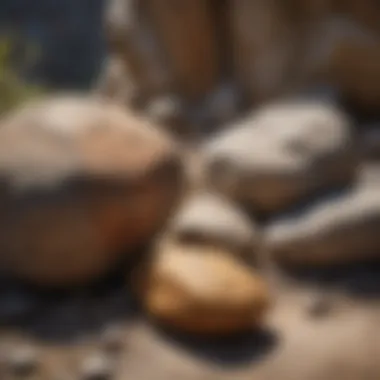Master the Art of Rock Bonding: A Guide for Collectors


Rock and Fossil Identification
As a rock and fossil collector, understanding the types of rocks and fossils is essential. Rocks can range from sedimentary, igneous, to metamorphic, each with distinct characteristics to look for. For instance, sedimentary rocks often have visible layers, igneous rocks form from cooling lava or magma, and metamorphic rocks undergo intense heat and pressure. Fossils, on the other hand, can be remnants of ancient plants or animals preserved in rock formations. To accurately identify rocks and fossils, collectors utilize tools such as magnifying glasses, geologist hammers, and mineral testing kits.
Collecting Tips and Techniques
When it comes to collecting rocks and fossils, adhering to best practices is paramount for an enriching experience. Knowing where to find prime collecting sites, such as quarries, beaches, or exposed rock formations, can significantly enhance your collection. Once at a site, safely extracting specimens without causing damage requires finesse and precision. Tools like chisels, brushes, and safety goggles are essential for successful extraction while preserving the integrity of the specimens.
Preservation and Display
Preserving rocks and fossils is crucial to maintaining their quality for future generations. Techniques like cleaning with soft brushes or water, and using consolidants to stabilize fragile specimens can prevent degradation over time. Proper storage methods involve storing rocks and fossils in acid-free containers with cushioning material to prevent breakage. For creative display ideas, collectors often use shadow boxes, display cases, or mounting specimens on stands to showcase their collection artistically.
Geological Insights
Delving into the geological aspects of rocks and fossils can provide valuable insights for collectors. Understanding geological formations and processes that lead to the creation of rocks and fossils adds depth to your appreciation of these natural wonders. Exploring the historical significance of certain rocks or fossils, like those with ties to significant events or ancient civilizations, can offer a deeper connection to the past. Moreover, learning about notable discoveries in the field of geology, such as new dinosaur species or unique mineral formations, fuels curiosity and drives further exploration in the world of rocks and fossils.
Introduction
The art of effectively gluing rocks together is a crucial skill for rock and fossil collectors, as it enhances specimen preservation, display aesthetics, and overall collection security. This comprehensive guide aims to provide valuable insights and techniques for both novice and experienced collectors to elevate their rock bonding practices.
Understanding the Importance of Glueing Rocks Together
Preservation of Specimens
Preservation of specimens plays a vital role in maintaining the integrity and longevity of rock and fossil collections. By securely bonding rocks together, collectors ensure that delicate specimens remain intact, preventing damage or disintegration over time. The meticulous attention to detail in preserving specimens enhances the historical and scientific value of each rock, contributing to the overall significance of the collection.
Enhancing Display Aesthetics
Enhancing the display aesthetics of rocks through skillful bonding techniques is essential for creating visually appealing showcases. By investing time in artful rock gluing, collectors can arrange rocks in aesthetically pleasing configurations, highlighting natural patterns and unique features. This attention to detail not only improves the visual impact of the collection but also showcases the collector's appreciation for the inherent beauty of rocks.
Securing Fragile Rocks


Securing fragile rocks is a critical aspect of rock gluing that ensures the stability of delicate specimens within a collection. Fragile rocks, prone to breakage or detachment, require specialized bonding techniques to reinforce their structural integrity. By employing secure bonding methods, collectors can confidently display fragile rocks without the risk of damage, preserving these specimens for future admiration.
Overview of Glueing Techniques
Surface Preparation
Effective surface preparation is key to facilitating strong adhesive bonds between rocks. By meticulously cleaning and roughening surfaces, collectors create optimal conditions for adhesion, ensuring that the glue penetrates and binds effectively. Proper surface preparation enhances the overall strength and durability of the bond, preventing detachment or weakening over time.
Application Methods
Choosing the right application method is crucial for achieving precise and controlled adhesive placement. Whether using brushes, syringes, or other specialized tools, the application method influences the coverage, thickness, and distribution of the adhesive. By selecting the most suitable application technique for each bonding scenario, collectors can achieve consistent and reliable results in their rock gluing endeavors.
Drying and Curing
Allowing sufficient time for adhesives to dry and cure is essential for establishing a strong and permanent bond between rocks. Proper drying and curing times vary depending on the adhesive type and environmental conditions, ensuring that the bond reaches its full strength. By adhering to recommended drying and curing processes, collectors can trust in the longevity and durability of their rock bonds.
Types of Adhesives for Rock Bonding
Epoxy Resin
Epoxy resin is a versatile adhesive known for its high strength and durability, making it a popular choice for bonding rocks. Its ability to withstand varying temperatures, pressures, and environmental factors ensures a reliable bond in diverse collecting environments. Additionally, epoxy resin offers transparency options, allowing collectors to maintain the natural appearance of rocks while securing them effectively.
Cyanoacrylate (Super Glue)
Cyanoacrylate, commonly referred to as super glue, is prized for its quick bonding properties and ease of use in rock gluing applications. This fast-acting adhesive forms an instant bond between rocks, ideal for small, precise bonding tasks. However, its lack of flexibility and tendency to create visible seams may require additional refinements for seamless results in certain rock bonding projects.
Silicone Adhesive
Silicone adhesive provides a flexible and resilient bonding solution for rocks, offering shock absorption and vibration resistance. Its waterproof properties make silicone adhesive a suitable choice for outdoor rock displays or humid environments. While silicone adhesive presents challenges in terms of visibility and refinishing, its durable and weather-resistant characteristics make it a valuable asset for securing rocks in dynamic settings.
Best Practices for Glueing Rocks Together
In the realm of rock and fossil collecting, the application of proper techniques for gluing rocks together is paramount. This section delves into the essence of best practices, emphasizing the significance of meticulous adhesive selection and application. By adhering to these best practices, collectors can ensure the longevity, stability, and aesthetic allure of their prized specimens. Each choice made in the process of glueing rocks together plays a pivotal role in preserving the integrity and beauty of the collection.


Choosing the Right Adhesive for Each Rock Type
Porosity Considerations
Porosity considerations are crucial when choosing the right adhesive for rock bonding. The porosity of the rocks determines how well the adhesive will penetrate and create a strong bond. Understanding the porosity of each rock type allows collectors to select the most suitable adhesive that can effectively bind the rocks together. This consideration is fundamental in achieving durable and seamless bonds that enhance the overall appeal of the collection.
Weight-Bearing Capacity
Weight-bearing capacity is a key factor to ponder when selecting adhesives for rock bonding. Different rocks vary in weight, and it is imperative to choose an adhesive that can withstand the load without compromising the bond's strength. By considering the weight-bearing capacity of the adhesive, collectors can securely affix heavier rocks together, ensuring stability and durability in their exhibits.
Translucency for Fossils
Translucency is a critical attribute to contemplate, especially when working with fossils. The transparency of the adhesive impacts how well the fossil's intricate details and textures remain visible after bonding. Opting for a translucent adhesive ensures that the fossil's characteristics are preserved, allowing collectors to showcase their fossils in all their glory. Translucency plays a pivotal role in maintaining the authenticity and visual appeal of fossil displays.
Ensuring Proper Adhesion Strength
Pressure Application
The application of pressure during the bonding process is essential to achieve proper adhesion strength. Applying consistent pressure ensures that the adhesive spreads evenly across the surfaces, creating a robust and enduring bond. By employing pressure application techniques, collectors can enhance the cohesion between rocks, minimizing the risk of detachment or weakening of the bond over time.
Alignment Techniques
Alignment techniques are instrumental in ensuring a seamless and professional finish when glueing rocks together. Proper alignment of the rocks before bonding guarantees precise positioning, resulting in aesthetically pleasing displays. By mastering alignment techniques, collectors can achieve flawless seams and transitions between rocks, elevating the visual appeal and overall quality of their collections.
Testing Bond Integrity
Testing the integrity of the bond is a critical step in the glueing process. Conducting thorough tests to assess the strength and durability of the bond helps identify any weaknesses or inconsistencies that require rectification. By meticulously testing bond integrity, collectors can rest assured that their exhibits are securely bonded, safeguarding against potential damage or deterioration.
Avoiding Common Mistakes in Rock Glueing
Excessive Adhesive Application
One common pitfall to avoid in rock glueing is the overapplication of adhesive. Excessive adhesive can lead to messy seams, glue residue, and compromised aesthetics. By exercising restraint and applying the appropriate amount of adhesive, collectors can achieve clean, seamless bonds that highlight the natural beauty of the rocks without detracting from their intrinsic appeal.


Impact on Geological Value
The impact of glueing on the geological value of rocks is a crucial consideration for collectors. Improper glueing techniques or using unsuitable adhesives can diminish the scientific and monetary value of the specimens. It is imperative to employ best practices to preserve the geological integrity of the rocks, ensuring that the bond does not detract from their significance or desirability among collectors and researchers.
Visible Residue
Visible residue left behind from glueing rocks can detract from the overall presentation of the collection. Unsightly residues can mar the aesthetic charm of the rocks, diminishing their visual appeal. By taking care to clean excess adhesive and eliminate visible residues, collectors can showcase their specimens with clarity and elegance, allowing the natural beauty of the rocks to shine through.
Advanced Tips for Rock and Fossil Collectors
In the realm of rock and fossil collecting, advanced tips can elevate your craft and showcase your specimens in their best light. These tips are not just about glueing rocks together; they delve into creating natural-looking seams that seamlessly blend rocks and fossils, enhancing the overall aesthetic appeal. One of the key elements of advanced tips is the art of creating natural-looking seams, a skill that requires mastery of blending techniques, utilization of mineral dust, and paint and pigment matching.
Creating Natural-Looking Seams
- Blending Techniques: Within the world of rock artistry, blending techniques are paramount. They allow collectors to seamlessly merge rocks without any visible demarcation. The key characteristic of blending techniques lies in their ability to create a smooth transition between rocks, ensuring a cohesive appearance. This technique is highly beneficial for this article as it adds a touch of realism to the bonds, making them visually appealing. However, overusing blending techniques can sometimes result in a loss of individual rock identity.
- Utilizing Mineral Dust: Mineral dust serves as a subtle yet effective means to enhance the natural appearance of seams. By incorporating mineral dust into the adhesive, collectors can mimic the natural colorations and textures of rocks, providing a seamless blend. Its unique feature lies in its ability to add authenticity to the bonding process. However, excessive use of mineral dust may lead to a gritty texture that takes away from the overall aesthetic.
- Paint and Pigment Matching: Matching paints and pigments to the rocks being bonded is a meticulous task that yields exceptional results. This technique ensures that the seams disappear into the rocks, creating a flawless finish. The key characteristic of paint and pigment matching is its precision in color replication, seamlessly integrating the rocks. Its advantage in this article is the ability to conceal seams beautifully, elevating the overall appearance. However, improper matching can result in visible discoloration that detracts from the bond's quality.
Conclusion
In closing, the significance of mastering the art of effectively gluing rocks together cannot be understated in the realm of rock and fossil collection. Through meticulous attention to detail and adherence to best practices, collectors can elevate the durability, aesthetic appeal, and overall value of their prized specimens. By embracing the techniques and adhesive options outlined in this guide, enthusiasts can achieve a profound sense of accomplishment and satisfaction in preserving geological marvels for generations to come.
Enhancing Your Rock Collection Through Secure Bonding
Appreciating the Art of Rock Glueing
Delving into the realm of rock glueing unveils a realm where science meets artistry. Appreciating the intricacies of bonding rocks involves a deep understanding of geological composition, structural integrity, and aesthetic coherence. By mastering the art of seamless adhesion, collectors can augment the beauty and stability of their rock displays, showcasing nature's diverse tapestry in a harmonious union. The delicate balance between precision application and artistic vision encapsulates the essence of rock glueing, offering enthusiasts a transformative journey of creativity and preservation.
Exploring the realm of appreciating the art of rock glueing unravels a realm where every fissure filled, every seam blended, contributes to a masterpiece of geological craftsmanship. The nuances of color matching, texture blending, and structural reinforcement merge to form a cohesive display that honors the unique characteristics of each rock while harmonizing them into a unified whole. Embracing the artistry of rock glueing not only elevates the visual allure of a collection but also instills a profound sense of pride in the meticulous care and skill required to achieve such bonded perfection.
Contributing to Preservation Efforts
Consider the broader implications of contributing to preservation efforts within the domain of rock and fossil collection. Beyond the individual satisfaction gained from creating durable bonds between rocks lies a deeper responsibility towards safeguarding Earth's geological heritage. By employing sound adhesive techniques and materials that minimize harm to specimens and promote lasting integrity, collectors play a vital role in ensuring that invaluable geological artifacts endure for future appreciation and study.
Engaging in preservation efforts through conscientious bonding practices embodies a commitment to honoring the inherent value of rocks and fossils, not just as collectible items but as invaluable windows into Earth's past. By prioritizing the longevity and authenticity of specimens through secure bonding methods, enthusiasts contribute to a legacy of geological stewardship that transcends mere acquisition, fostering a culture of respect for the wonders of the natural world.
Showcasing Your Collection with Confidence
The ability to showcase a rock collection with confidence rests not only on the aesthetic appeal of bonded specimens but also on the trust in their structural resilience. Confidence in display stems from the knowledge that each rock is securely adhered, able to withstand the test of time and manipulation without compromising its visual impact. By meticulously bonding rocks with expert precision, collectors can curate exhibitions that dazzle the eye and withstand scrutiny, inviting admiration and scholarly inquiry with unwavering assurance.
Embarking on the journey of showcasing your collection with confidence elevates the act of displaying rocks from mere presentation to profound storytelling. Each securely bonded rock becomes a chapter in a larger narrative of Earth's geological wonders, a testament to the collector's dedication to preserving and presenting nature's rarities in their best possible light. The confidence exuded in a meticulously curated collection speaks volumes about the curator's passion, expertise, and unwavering commitment to the art and science of rock and fossil collection.







